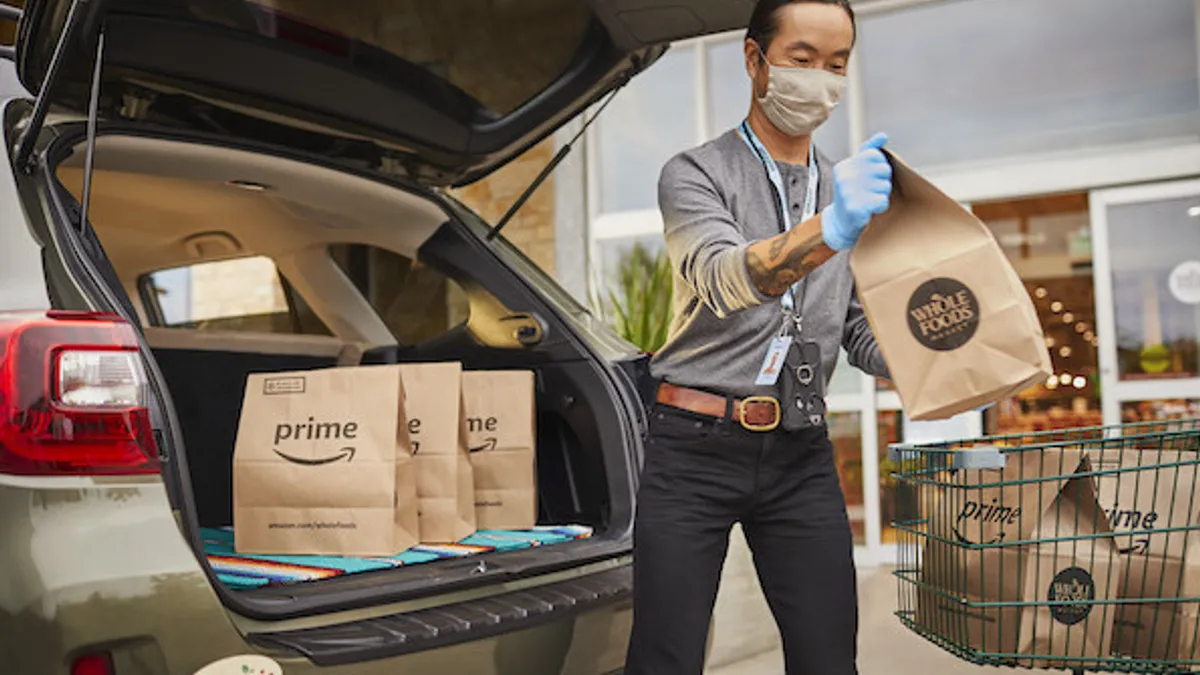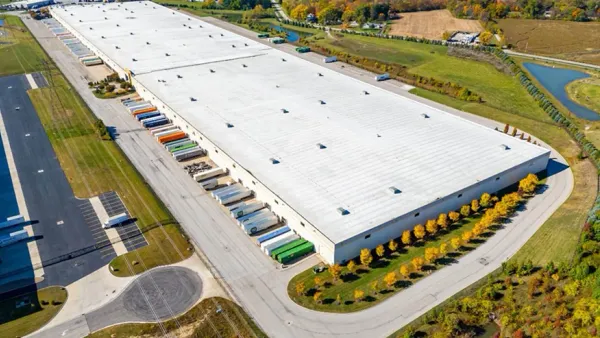For grocers and consumers alike, pickup has become the preferred e-commerce service during the pandemic. Shoppers enjoy the convenience and familiar routine of driving to their local store — not to mention the fee-free fulfillment a few large chains have implemented — while retailers appreciate the favorable profit margins compared to delivery.
Some chains, like Kroger and Walmart, have been able to leverage an already sizable pickup footprint, while others have scrambled to implement it at their stores. Companies have added pickup spaces and time slots in recent months. They're also evaluating ways to make the service faster and more convenient for shoppers while making fulfillment more efficient.
Here's a closer look at how six chains have expanded pickup during the pandemic.

Kroger had a large base of stores offering pickup at the beginning of 2020, having roughly doubled its number of locations over the past two years, from 1,056 in fiscal Q1 of 2018 to about 2,100 locations currently, according to data compiled by banking and financial services company Rabobank.
The grocer has waived fees during the pandemic and added more pickup slots and parking spaces at its stores — and has funneled up millions of new shoppers as a result.
"We find customers find pickup incredibly flexible on their schedule, much more so than delivery," Kroger CEO Rodney McMullen said during the company's Q2 earnings call in September.
In April, Kroger began accepting SNAP payments through its pickup program. It also offers delivery from about 2,400 stores.

Walmart has also benefited from having a large base of stores offering free pickup, having more than doubled the service's availability, from 1,400 locations in fiscal Q1 of 2018 to nearly 3,500 currently, according to data compiled by Rabobank.
The service is the most trusted among grocery pickup providers, according to a recent survey by BrandSpark. And Walmart had the fastest curbside service among chains measured by Rakuten Ready, with average wait times of just over two minutes.
The steeper growth for Walmart during the pandemic occurred in delivery, which expanded from 1,600 stores in February to more than 2,700 as the retailer rolled out Express Delivery, as well as unlimited delivery through its Walmart+ membership program. It also partnered with Instacart in August to start delivering groceries in four markets.

Albertsons' e-commerce strategy leading up to this year has focused primarily on delivery, including its own delivery service, which is available in 12 of the top 15 markets, a spokesperson with the chain said. The company's Drive Up & Go pickup service has been slower to expand, but it's increased locations by more than 70% over the course of year so far, particularly July and October, as the company saw consumer interest shoot up.
CEO Vivek Sankaran has said Albertsons is quickly making improvements to pickup fulfillment and sees technology like automated micro-fulfillment as a way to drive costs further down.
"We think we have line of sight to a profitable Drive Up & Go business. And that’s why we’re investing faster in it," he said during the company's earnings call in October.
Like Kroger, Albertsons has waived pickup fees, and it plans to extend Drive Up & Go to 1,400 stores by next year.

Target has offered in-store pickup since 2013 and curbside pickup has grown rapidly since it launched in 2017. But it wasn’t until this year that the company began adding fresh and frozen groceries to the service.
Its click-and-collect grocery pilot kicked off in its hometown of Minneapolis in March, but it was put on hold later that month when the pandemic hit before resuming in late spring. After seeing demand soar, Target hit the gas on grocery pickup over the summer, more than tripling availability in just three months.
The rollout pace is "far exceeding our original goal," John Hulbert, Target's vice president of investor relations, said during the company's Q4 earnings call in August. The company also offers alcohol pickup in more than 300 stores and expects to offer grocery items for pickup at close to 1,600 stores by the holidays.

Ahold Delhaize started the year with close to 700 click-and-collect locations across its five U.S. banners and has been gradually adding more, particularly in its Food Lion banner, which introduced pickup services at more than 60 stores this fall.
Next year, the company will increase pickup availability by nearly 60% as it also pilots other e-commerce programs, including a subscription program and digital marketplace.

Whole Foods has gone all-in on pickup, harnessing the resources and expertise of parent company Amazon to unlock the service at all of its U.S. locations. Suburban locations offer curbside service, while the chain’s many urban locations offer pickup from the customer service counter. Pickup is free for Amazon Prime members who place orders of $35 or more.
When announcing its nationwide pickup availability last month, the company said more than 40% of customers who use the service each month are doing so for the first time, and noted GlobalData research saying nearly 68% of shoppers say they will continue using grocery click-and-collect options after the pandemic has subsided.















